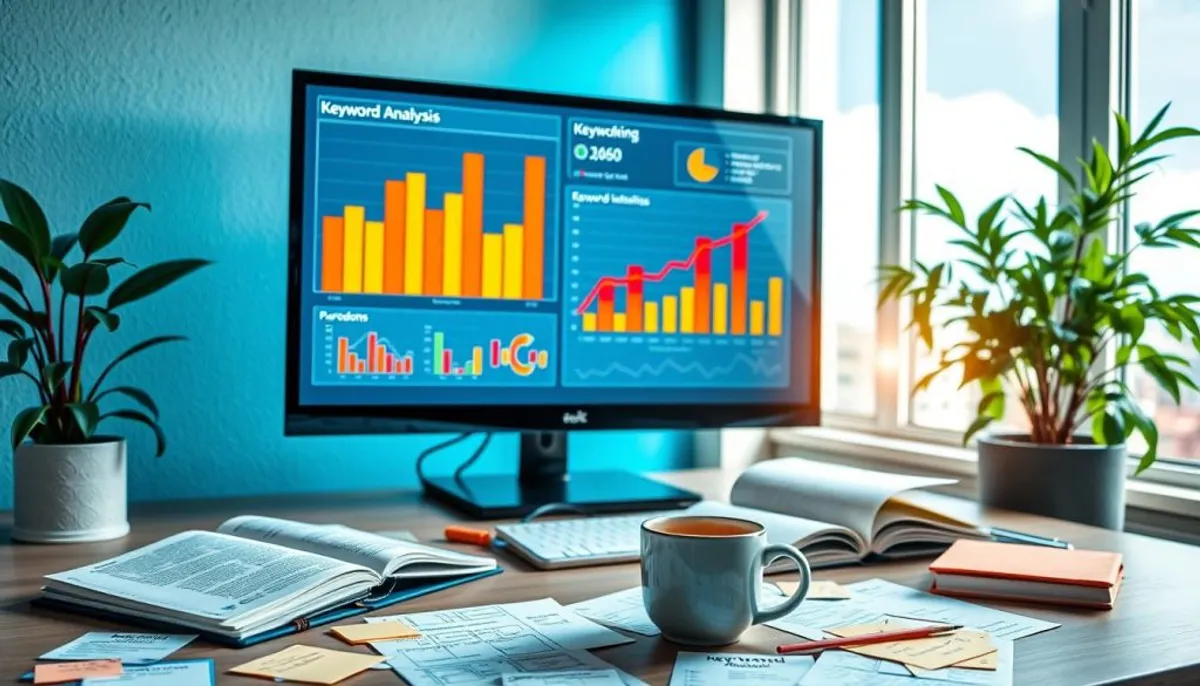In today’s digital world, SEO and SEM are key to boosting online visibility. These strategies help businesses climb search engine rankings and attract targeted traffic. SEO focuses on organic growth, while SEM includes both paid and unpaid methods to enhance digital marketing.
Did you know organic search accounts for 53% of all website traffic? This highlights the need to be search engine friendly. With Google handling over 8.5 billion searches daily, businesses prioritize SEO and SEM in their marketing plans.

The global SEO industry is set to reach $122.11 billion by 2028, showing its growing importance. SEO results may take months, but PPC campaigns can drive instant traffic. This mix of short-term gains and long-term growth makes SEM invaluable for businesses of all sizes.
At UnlimitedVisitors.io, we grasp the power of these strategies. Our all-in-one SEO tool automates blog creation, helping you attract visitors and convert them into loyal customers. By using both SEO and SEM, you can maximize your online presence and achieve sustainable business growth.
Understanding the Digital Marketing Landscape
The digital marketing landscape has undergone a significant transformation with the rise of search engines. Google, in particular, has become the dominant force, handling billions of searches every day. This shift has dramatically altered how businesses approach their online presence and growth strategies.
Evolution of Search Engines
Search engine algorithms have evolved, impacting digital marketing trends. Today, only 22% of top search results are less than a year old. This highlights the long-term commitment required for SEO efforts. The evolution has made the online environment more competitive, necessitating continuous adaptation for businesses to remain visible.
The Role of Digital Marketing in Modern Business
Digital marketing is essential for business growth. It encompasses various strategies, including SEO and SEM, to enhance online presence. SEO focuses on organic traffic, while SEM involves paid advertising. Both are crucial for maximizing visibility and effectively reaching target audiences.
Current State of Search Marketing
The search marketing industry is experiencing rapid growth. Businesses are now integrating SEO and SEM into their strategies. This combination balances long-term sustainability with immediate results, adapting to changing user behaviors and preferences.
| Strategy | Timeline | Focus | Cost-Effectiveness |
|---|---|---|---|
| SEO | Long-term | Organic traffic | High |
| SEM | Immediate | Paid traffic | Variable |
| Combined | Balanced | Comprehensive | Optimized |
As the digital landscape continues to evolve, businesses must stay abreast of emerging trends. Voice search optimization and mobile marketing are becoming increasingly important. These reflect the changing user behaviors and preferences in the digital realm.
Search Engine Optimization and Search Engine Marketing: Core Differences
SEO and SEM are two essential strategies for enhancing online presence. SEO targets organic search rankings, whereas SEM covers both organic and paid methods for increasing traffic. Understanding their differences is crucial for effective digital marketing.
SEO is a long-term approach that requires patience. Businesses typically see notable improvements in organic rankings after three to six months. In contrast, SEM provides immediate visibility through paid search ads. This disparity influences how businesses allocate resources for maximum ROI.
Cost is a significant factor distinguishing these strategies. SEO demands less initial investment but requires more time and effort. SEM, especially PPC campaigns, involves direct costs for ad placement. The choice between SEO and SEM hinges on a company’s budget, timeline, and traffic generation goals.
| Aspect | SEO | SEM |
|---|---|---|
| Timeline | 3-6 months for results | Immediate results |
| Cost | Lower upfront, long-term investment | Higher upfront, ongoing costs |
| Focus | Organic search rankings | Organic and paid search visibility |
| Tactics | On-page, off-page, technical optimization | PPC, local SEO, display ads, remarketing |
SEO and SEM differ in their approaches but aim to enhance search visibility and drive traffic. Many businesses achieve optimal results by combining both strategies. This approach leverages the immediate benefits of paid search while fostering long-term organic growth.
The Fundamentals of SEO Strategy
SEO strategy is the cornerstone of online presence. It combines several elements to enhance your website’s search engine ranking. Let’s explore the essential components of a robust SEO foundation.
On-Page Optimization Elements
On-page optimization targets your website’s content and structure. It involves refining keyword research, optimizing meta tags, and producing high-quality content. Google favors sites that deliver value to users.
Off-Page Optimization Techniques
Off-page SEO enhances your site’s reputation. Link building is key here. Quality backlinks from reputable sites signal to search engines that your content is trustworthy and valuable.
Technical SEO Components
Technical SEO might seem daunting, but it’s vital. It encompasses improving site structure, enhancing page speed, and ensuring mobile-friendliness. These aspects significantly influence your site’s performance in search results.

Content Optimization Best Practices
Your content strategy is at the core of SEO. Develop original, relevant content that aligns with user intent. Regular updates and a focus on value are crucial. This approach satisfies search engines and keeps your audience engaged.
| SEO Factor | Weight in Google Ranking |
|---|---|
| High-Quality Content | 26% |
| Keywords in Meta Title | 17% |
| Backlinks | 15% |
| Niche Expertise | 13% |
By grasping these fundamentals, you lay a solid foundation for your SEO endeavors. SEO is a continuous journey. Stay abreast of new trends and continually refine your strategy for optimal outcomes.
Paid Search Marketing Essentials
Paid search marketing is a crucial tool for businesses aiming to thrive in today’s digital world. PPC campaigns, especially through Google Ads, provide a direct path to connect with potential customers. By bidding on keywords, advertisers can place ads on search engine results pages. This connects with buyers at the exact moment they are ready to make a purchase.
Effective PPC management hinges on several key elements:
- Keyword selection
- Ad copy creation
- Bidding strategies
- Budget management
- Quality Score optimization
Creating high-performing ad copy is essential for success in Google Ads. It must be compelling, relevant, and include keywords with high commercial intent like “buy,” “discount,” or “free shipping.” These keywords indicate a user’s readiness to purchase, boosting conversion rates.
Bidding strategies are critical to the success of PPC campaigns. Advertisers must balance their maximum bid with Quality Score to secure the best ad placement. This process, known as the ad auction, determines both ad position and cost.
| Metric | Impact |
|---|---|
| Quality Score | Influences ad position and costs |
| Mobile Optimization | 70%+ of shoppers buy using mobile phones |
| Organic vs. Sponsored | Top organic result gets 19x more clicks than top sponsored |
With 49% of shoppers using Google to discover new products and 40% of U.S. ad spending from search ads, mastering paid search marketing is vital for business growth in the digital era.
Key Metrics and Performance Indicators
Success in search marketing hinges on tracking essential metrics. Let’s explore the key performance indicators that fuel growth and shape strategy.
Organic Search Metrics
Organic traffic is a fundamental aspect of SEO success. It reflects the number of visitors reaching your site via search engines. Higher rankings lead to more traffic and conversions. Search visibility, showing how often your domain appears in results, is an early indicator of success.
Backlinks are crucial, but it’s the quality that matters most. Tools like Majestic assess link authority. Organic click-through rate significantly impacts traffic and ranking signals. Monitoring branded searches reveals users seeking your company, often resulting in high conversion rates.
Paid Search Analytics
In paid search, click-through rate and cost per click are paramount. These metrics are essential for optimizing ad performance and budget allocation. Quality Score, affecting ad placement and cost, is a critical focus for advertisers.
| Metric | Description | Ideal Range |
|---|---|---|
| Click-Through Rate (CTR) | Ratio of clicks to impressions | 2% – 3% |
| Cost Per Click (CPC) | Average cost for each click | Varies by industry |
| Quality Score | Ad relevance and landing page experience | 7 – 10 |
Conversion Tracking
Conversion rate is a key metric, measuring goal completions such as purchases or sign-ups. It’s crucial for both organic and paid efforts. ROI measurement compares net income to investment in optimization. Tools like Google Analytics offer insights into user behavior, aiding in refining strategies for enhanced performance.
Content Strategy for Search Success
A solid content strategy is crucial for boosting your search visibility. By focusing on content marketing and topic clusters, you can effectively target your audience and meet their search intent. Let’s dive into the essentials of creating a winning content strategy.
Keyword Research and Implementation
Begin with thorough keyword research to understand what your audience is searching for. Utilize tools like Google Suggest to find long-tail keywords, which are easier to rank for. Identify 4-5 main organic competitors and analyze their keyword rankings to spot content gaps.
Content Creation Guidelines
Quality is more important than quantity in content creation. Focus on producing valuable, original content that addresses user needs. Incorporate a “Hook” to attract backlinks and boost your SEO efforts. Over half of SEO professionals report improved rankings after increasing content output.
| Content Type | SEO Benefit | Best Practice |
|---|---|---|
| Blog Posts | Improves organic visibility | Optimize for featured snippets |
| In-depth Guides | Attracts backlinks | Use Skyscraper Technique 2.0 |
| Product Pages | Targets commercial intent | Implement semantic SEO |
Content Distribution Channels
Distribute your content across various channels to maximize reach. Your website, social media platforms, and industry forums are excellent starting points. Consistent publishing can lead to greater success in content and SEO strategies, potentially growing your organic traffic significantly.

By aligning your content with user needs and search engine requirements, you’ll be well on your way to content marketing success. Remember, high-quality content is essential for search engine visibility and engaging your target audience.
Technical Optimization Fundamentals
Mastering technical SEO is essential for website success. We concentrate on key areas that enhance your site’s performance and visibility. Let’s explore the basics of technical optimization!
Site speed is paramount. A slow website can lead to a 90% increase in bounce rates with load times from one to five seconds. We’ll optimize images and streamline code to ensure fast page loading.
Mobile optimization is now a must. With more searches on mobile devices, your site must be responsive and user-friendly on all screen sizes. We’ll assist in creating a seamless mobile experience.
Structured data is a powerful tool for rich snippets in search results. By using Schema.org markup, you’ll help search engines better understand your content, potentially increasing your visibility.
Crawlability is the cornerstone of SEO. We’ll demonstrate how to use XML sitemaps and optimize your site architecture. This ensures search engines can easily find and index your pages.
Security is crucial. Google has considered SSL a ranking factor since 2014. We’ll assist in securing your site with HTTPS, enhancing visitor trust and potentially improving search rankings.
| Technical SEO Element | Impact on SEO | Implementation Difficulty |
|---|---|---|
| Site Speed | High | Medium |
| Mobile Optimization | High | Medium |
| Structured Data | Medium | Low |
| Crawlability | High | Low |
| HTTPS | Medium | Low |
By focusing on these technical optimization fundamentals, you’ll establish a strong SEO foundation. Let’s collaborate to enhance your site’s performance and visibility in search results!
Local SEO and Business Visibility
Local search is a game-changer for small businesses. With 46% of Google searches focused on local information, optimizing your online presence is crucial. Let’s dive into strategies that boost your visibility and attract nearby customers.
Google Business Profile Optimization
Your Google Business Profile is your digital storefront. Keep it up-to-date with accurate info, photos, and posts. This profile is key for appearing in Google Maps and local search results. Remember, 61% of Google searches happen on mobile, so a well-optimized profile is vital.
Local Search Ranking Factors
Google considers relevance, distance, and prominence when ranking local businesses. NAP consistency across online platforms is crucial. This means your Name, Address, and Phone number should match everywhere. Reviews also play a big role. Encourage happy customers to leave feedback and respond promptly to all reviews.
Citation Building Strategies
Build citations on trusted websites to boost your local SEO. This verifies your business info and increases legitimacy. Use tools like Semrush to manage citations and monitor local listings. Don’t forget about social media – sharing content on your Google Business Profile can improve search rankings.
By focusing on these local SEO strategies, you’ll improve your visibility in local search results and Google Maps. This increased exposure leads to more foot traffic and sales for your business. Remember, in the world of local search, consistency and engagement are key to success.
Mobile Optimization and User Experience
In today’s digital world, mobile optimization is not just a choice—it’s a necessity. Over 50% of visitors to top websites use smartphones. This makes responsive design critical for businesses to remain competitive. Google’s move to mobile-first indexing further emphasizes this, making the mobile version of a website more important in search rankings.
Page speed is key for mobile success. Slow sites annoy users and harm SEO. To enhance user engagement, aim for fast load times and easy navigation. It’s worth noting that 62% of search results on smartphones are different from those on desktops, showing the need for a mobile-friendly approach.
User experience extends beyond speed. It includes readable content, easy-to-access buttons, and layouts that don’t require zooming. Google’s Core Web Vitals assess these aspects, such as loading speed, interactivity, and visual stability. Optimizing these can boost your search rankings and keep visitors longer, reducing bounce rates and increasing conversions.
RelatedRelated articles



